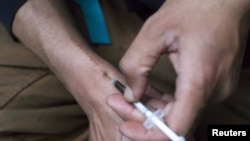Amid the growing opioid use crisis in the United States, a new study suggests heroin use is on the rise, particularly among younger white people.
According to researchers at Columbia University's Mailman School of Public Health, “The portion of Americans using heroin has climbed five-fold in the last decade, and clinically defined heroin dependence has more than tripled.”
They say the increases were most marked “among males, whites, those with low income and little education,” with the most pronounced increase among whites age 18 to 44.
"In 2001 to 2002, whites and non-whites reported similar prevalence of heroin use. However, in 2012-2013, increases in heroin and related disorders were particularly prominent among whites, leading to a significant race gap in lifetime heroin use by 2013," said Silvia Martins, MD, PhD, associate professor of Epidemiology at the Mailman School of Public Health.
According to the findings, heroin use rose from .33 percent to 1.60 percent from 2001-2002 to 2012-2013. Among whites, it grew from 1.1 percent to 1.9 percent over the same period.
Heroin use rose more sharply among unmarried adults than their married counterparts.
Researchers say the non-medical use of prescription painkillers was a driver for the increase in heroin use. In 2001-2002, 36 percent of heroin users who were white had used opioids recreationally before using heroin. In 2012-2013 that rose to 53 percent.
"Because the effects of heroin seem so similar to widely available prescription opioids, heroin use appears to have become more socially acceptable among suburban and rural whites," noted Martins.
Martins says the findings show action to stem heroin use is needed.
"Our results underscore the need to expand educational programs on the harms related to heroin use and access to treatment in populations at increased risk," said Martins. "Promising examples of prevention and intervention efforts include expansion of access to medication-assisted treatment — methadone, buprenorphine or injectable naltrexone — as well as educational campaigns in schools and community settings, and consistent use of prescription-drug monitoring programs."
The findings are published online in JAMA Psychiatry.








